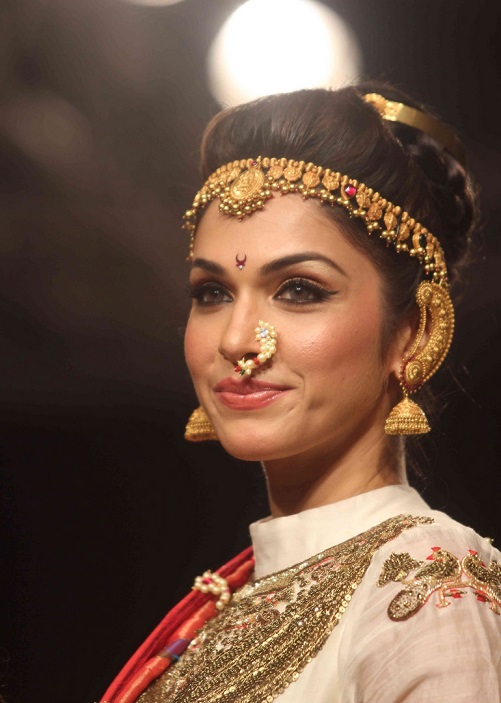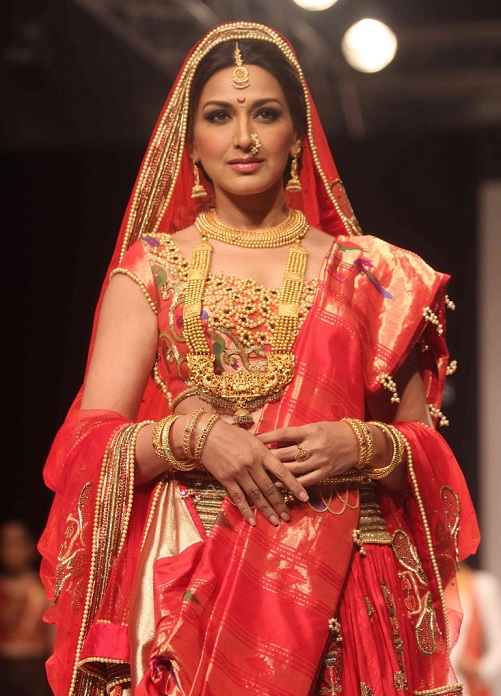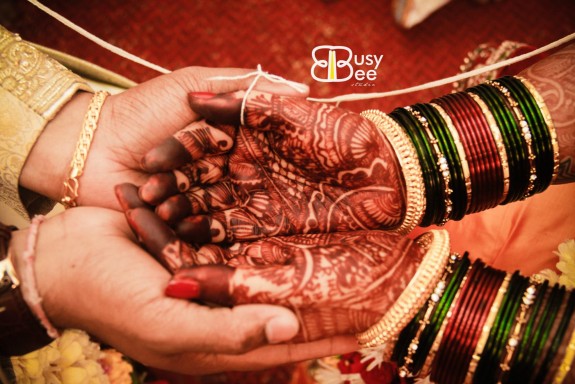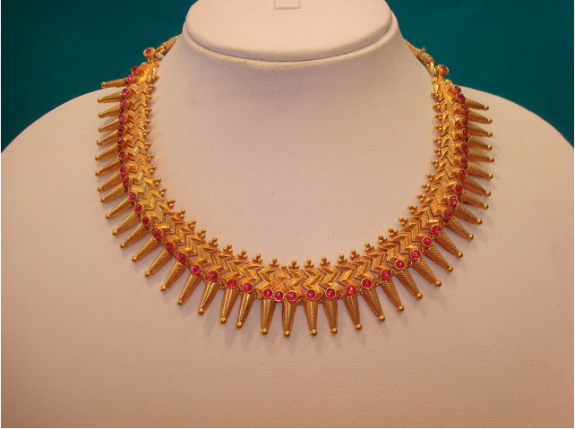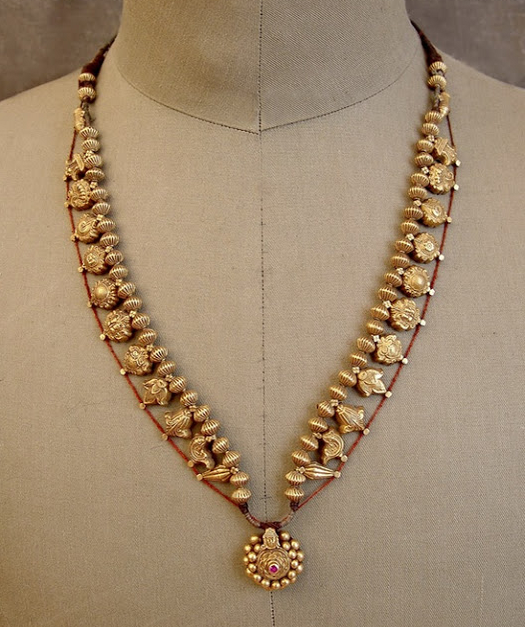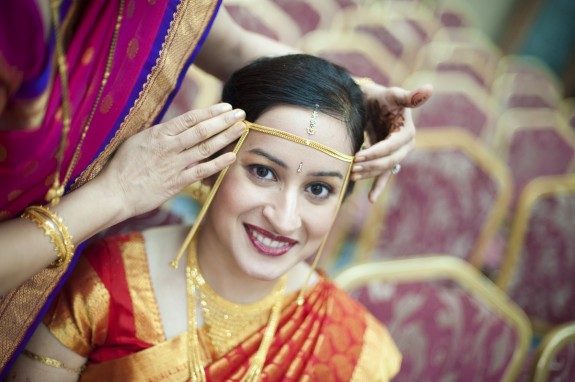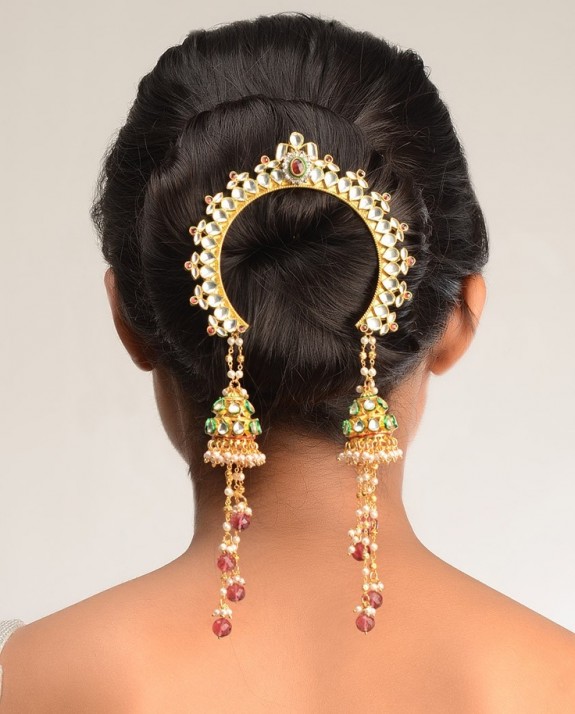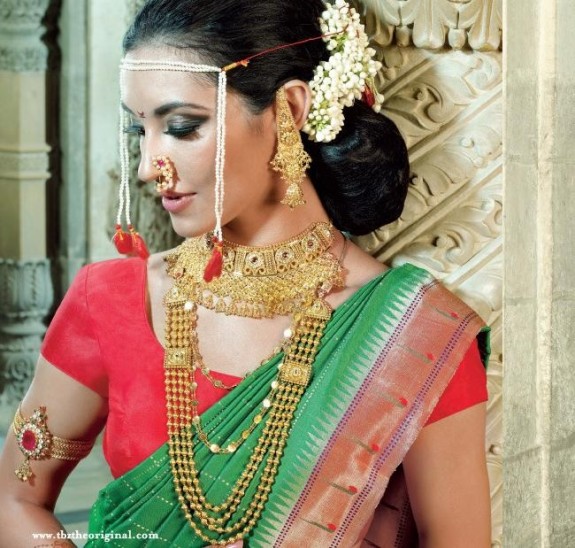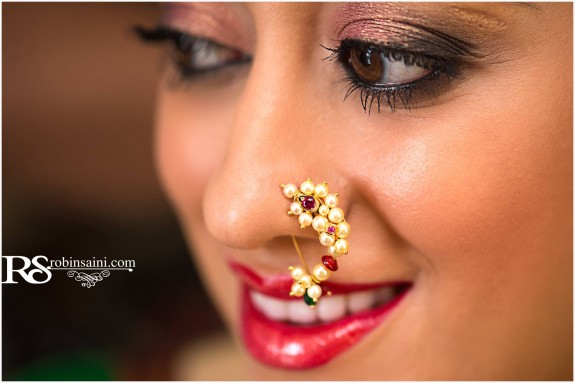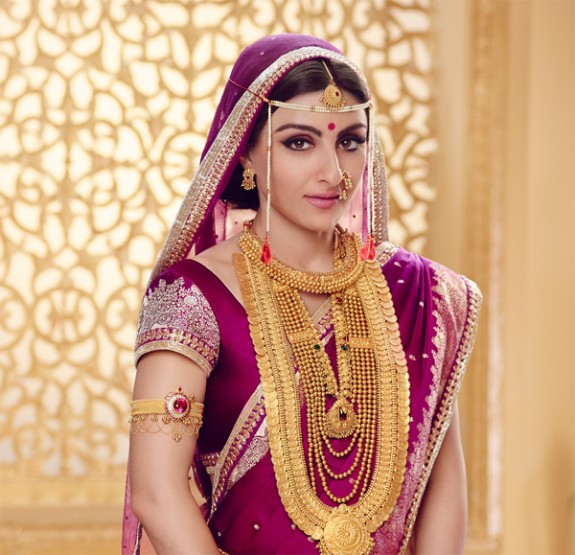Maharashtrian weddings feature a unique collection of jewelry that comes with a lot of history (along with gold and sparkle!).
Isha Koppikar; Photo via FashionWorld Hamood
Traditionally, the jewelry worn by a Maharashtrian bride is handed down from generations – from her grandmother to her mother and down to her. It therefore carries a lot of meaning, but it also means that each piece tells a personal story of the family’s wealth, success, religion, and values. Each piece also tends to be a valuable item that the bride will prize and save for her daughter or daughter-in-law.
Sonali Bendre; Photo via FashionWorld Hamood
The major Maharashtrian jewelry items consist of:
Thushi
Photo via Kothari Jewelry
Thushi necklaces are thick chains of closely-placed golden balls held together by a leather strand or piece of rope. The necklace is worn right at the base of the neck, so it is the first piece of jewelry a bride will wear below the necklace. Each minute ball on the thushi is carefully crafted from pure gold and embellished with intricate shapes and designs. The necklace can be furthered adorned with lac centerpieces for color and variety.
Pichodi Bangles
Photo via Busy Bee Studio
A bride often wears a set of 2 pichodi bangles at each wrist, in additional to green and pearl bangles, to adorn her arms for the wedding ceremony. Pichodi bangles are thin, gold bangles often made with a high-quality gold (24 karat) with a copper base for sturdiness. The bangles can be intricately decorated with religious motifs or floral and animal figures. Modern tradition has enhanced these bangles with precious stones or glass, and some pichodi bangles are made with white gold instead of the traditional yellow.
Kolhapuri Thushi
A traditional Maharashtrian thushi necklace that is influenced from the traditional styles of Kolhapur, in southwest Maharashtra. The necklace is known for its lightweight feel, which is useful considering the bride is wearing quite a lot of gold jewelry on her wedding day. A Kolhapur thushi will always have a leather dora (string) to tie the golden balls of the necklace together.
Champakali haar
A flower-themed choker necklace that sits at the base of the bride’s neck. It is made of gold beads closely strung together. The beads are pointed to resemble a flower’s petals, and they can be embellished with metal, glass, or precious stones to reflect red, orange, and other bright colors that one might find on a flower.
Toda
A bride usually wears at least one set of gold toda bangles on her wrists. These bangles are thick gold bands that can be engraved with patterns and motifs – although Maharashtrian bangles tend to be simpler in design.
Putli Haar
A longer necklace, the putli haar, is a gold chain that hangs at least a foot below the bride’s neck. It is another traditional necklace that hails from Kolhapur, and it is made of gold beads or discs closely sewn together. These beads or discs often contain religious motifs of Laxmi or the goddess Sita, who was an avatar of Laxmi – the goddess of wealth. The heavy gold structure of the necklace represents wealth and fortune for the bride and her groom.
Surya Haar
Photo via Jewellery India
Similar to a champakali haar, this tight, gold choker necklace is made to resemble the sun’s (surya’s) rays instead of a floral garland. The beads are very closely tied together, and the pointed, triangular beads all face outward to resemble the warming rays of the sun. Colored jewels can also adorn the necklace. A bride will usually wear only one type of choker necklace for her wedding ceremony.
Saaz
Photo via Jewellery India
A saaz is a studded, long Kolhapuri necklace with a jeweled pendant. The surrounding beads are made with gold and tend to be chunky – the necklace itself hangs low, at least a foot, below the bride’s neck. The beads and jewelled pendant are held together by a string. The colored jewels or beads on the necklace tend to be a bright green or red – both colors commonly worn in Maharashtrian weddings.
Maniwati
Maniwati beads are black and gold and used in the mangalsutra – a traditional gold necklace worn by married women. The maniwati beads are lightweight and small, and they compose a necklace that can range in weight and length. Typically, maniwati beads have little or no designs or patterns on them, but the beads at the center of the mangalsutra tend to be more elaborate and larger.
Challa keyring
A colorful, jewelled pendant that is hung from the bride’s saree at the waist. The challa is made of gold-plated copper and adorned with diamonds or other jewels. These elements are arranged in a singular design – often a common motif such as peacocks, flowers, or paisley.
Mundavalya
Photo via Anshum M Photography
This headpiece is worn by both the bride and the groom on their wedding day – it is often made of pearls and flowers and hangs in two strings down the side of the face. It can also be made of gold or other metals.
Ambada
Photo via exclusively.com
The ambada is a golden pin with pearls and jewels that is pinned at the top of the bride’s bun for her wedding ceremony. Maharashtrian brides generally tie their hair in a tight bun at the back of their heads and arrange a string of white flowers, generally jasmines, around the bun. The ambada is a jewelled embellishment that adds to the bride’s hairdo.
Dholki
A dholki necklace is made with rounded pearls that can vary in color from white, yellow, and red. The pearls are arranged in a single strand, often with other decorative beads or center stones for embellishment. These necklaces are shorter in length and can be worn with other necklaces during the wedding ceremonies.
Moti kaan
Photo via tbztheoriginal
Moti kaan literally translates to “big earrings” in Marathi. Brides will wear heavy, gold earrings that are embellished with colorful jewels and pearls. The earrings will generally be large studs as opposed to dangling earrings, but this practice has evolved in modern times. Kaan earrings in particular refer to the use of pearls in the jewelry.
Nath
Photo via Robin Saini Photography
A nath is typical Maharashtrian nosepin adorned with pearls and jewels. The unique dangling shape of the nath makes it a standout piece that the bride usually wears throughout the ceremony. It even comes in clip-ons, which some brides opt to wear to avoid getting a nose piercing.
Bormaal
Soha Ali Khan; Photo via Vishesh Varma
This long, beaded necklace is made with wax beads covered in gold plating. The beads will be of a consistent shape and size – generally rounded. The entire ensemble is held together by a brown or red string. The necklace is one of the longer pieces that a bride will wear, as it can hang as low as mid-way to her waist.

